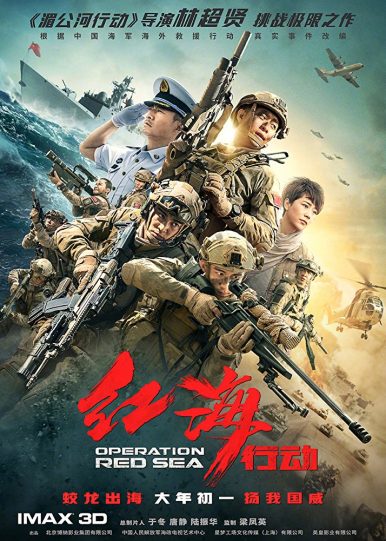By Robert Farley
 Although it largely escaped the notice of American audiences, Dante Lam’s Operation Red Sea served to introduce the Chinese public to its new navy. Directed by Lam and starring Zhang Yi, Hai Qing, and Huang Jingyu, the film was a huge success, making $579 million domestically, enough for second place all time in the Chinese box office. In addition to being an enjoyable enough action-thriller, Operation Red Seaopens a valuable window onto how the People’s Liberation Army Navy (PLAN) wants to manage its public image.
Although it largely escaped the notice of American audiences, Dante Lam’s Operation Red Sea served to introduce the Chinese public to its new navy. Directed by Lam and starring Zhang Yi, Hai Qing, and Huang Jingyu, the film was a huge success, making $579 million domestically, enough for second place all time in the Chinese box office. In addition to being an enjoyable enough action-thriller, Operation Red Seaopens a valuable window onto how the People’s Liberation Army Navy (PLAN) wants to manage its public image.
The sometimes convoluted plot boils down to crisis response off the coast of Africa. Loosely based on PLAN anti-piracy ops, and on the rescue of Chinese citizens from Aden, Yemen during the civil war, the film opens with a commando attack against a group of pirates who have seized a freighter, and then develops into a much larger raid to rescue Chinese hostages from Islamic State-affiliated terrorists.
The call-outs to American films are obvious: The pirate sequence at the beginning reminds the viewer of Captain Phillips, without the calming presence of Tom Hanks, and the hostage rescue raids evoke Black Hawk Down. The overall thrust is similar to that of Michael Bay’s Thirteen Hours, with which it shares a garish depiction of military violence. Lam does not skimp on the blood, the dismemberment, or any other horrific depictions of the consequences of war.
The film combines political and apolitical perspectives. The imprint of the PLAN is glaring and obvious, as the commandos rarely hesitate to declare their institutional affiliation before gunning down some nameless terrorists. This, the message is clear, is what China’s navy can do for China.
On the other hand, 40 years ago a Chinese military film might have sought to draw a contrast between American and Chinese treatments of Africans. Operation Red Sea simply seeks to demonstrate that the Chinese Navy can be every bit as lethal as its American counterpart. If anything, the targets of the Chinese Navy are less well-drawn than the typical terrorist or pirate stereotypes that populate American films.
But Operation Red Sea is extraordinarily well done. The PLAN reportedly poured money into the film, and there’s no question it got what it was paying for; the movie is gorgeously well-executed, with many extravagant set pieces and some exceptional air and sea shots. Indeed, the purported $70 million price tag seems low, given the effectiveness of many of the shots.
Operation Red Sea does not include a meditation on how China might manage the international community differently than the United States. It barely mentions the United States at all, except for a brief moment in which the victims of a terrorist attack mistake Chinese marines for Americans (“American. Please. Save my kid”). Rather, the message of Operation Red Sea is quite clearly that the Chinese military can do the things that the United States military does just as effectively as the Americans. Kill pirates with snipers? Blow up terrorists with drones? Rescue hostages in a blood drenched raid against a terrorist camp? Check, check, check.
The film ends on a distinctly different note, however. A squadron of Chinese ships in the South China Sea intercepts what appears to be a squadron of American ships, as a voice-over repeats the warning “You are entering Chinese waters. Please turn around.”
Footage of J-15 “Flying Shark” fighters launching from the carrier Liaoning plays over the credit sequence. The message is clear: the Chinese can kill just as efficiently as the Americans, and consequently the U.S. Navy needs to be very careful about how it handles itself.
The views expressed here are his personal views and do not necessarily reflect those of the Department of Defense, the U.S. Army, the Army War College, or any other department or agency of the U.S. government.
No comments:
Post a Comment